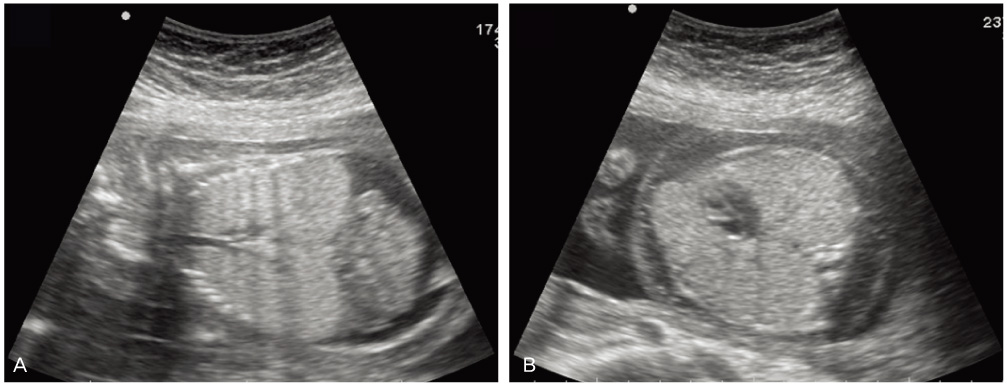Korean J Obstet Gynecol.
2012 Feb;55(2):115-118. 10.5468/KJOG.2012.55.2.115.
A case of congenital high airway obstruction syndrome caused by complete tracheal obstruction with associated anomalies
- Affiliations
-
- 1Department of Obstetrics and Gynecology, Haeundae Paik Hospital, University of Inje College of Medicine, Busan, Korea.
- 2Department of Pathology, Haeundae Paik Hospital, University of Inje College of Medicine, Busan, Korea.
- 3Department of Obstetrics and Gynecology, Asan Medical Center, University of Ulsan College of Medicine, Seoul, Korea. hswon@amc.seoul.kr
- KMID: 2078124
- DOI: http://doi.org/10.5468/KJOG.2012.55.2.115
Abstract
- Congenital high airway obstruction syndrome (CHAOS) is caused when the upper airway is obstructed or severely narrowed. The prenatal ultrasound findings of CHAOS include large echogenic lungs, inverted diaphragms, dilated airways, and fetal ascites and/or hydrops. Recently, exutero intrapartum treatment (EXIT) procedure or fetoscopic tracheostomy are being widely used for the treatment of CHAOS. However, CHAOS with early presentation of hydrops confers ominous sign even with EXIT procedure. We report a case of CHAOS with hydrops and associated anomalies that was confirmed by autopsy.
Figure
Reference
-
1. Hedrick MH, Ferro MM, Filly RA, Flake AW, Harrison MR, Adzick NS. Congenital high airway obstruction syndrome (CHAOS): a potential for perinatal intervention. J Pediatr Surg. 1994. 29:271–274.2. Lim FY, Crombleholme TM, Hedrick HL, Flake AW, Johnson MP, Howell LJ, et al. Congenital high airway obstruction syndrome: natural history and management. J Pediatr Surg. 2003. 38:940–945.3. Courtier J, Poder L, Wang ZJ, Westphalen AC, Yeh BM, Coakley FV. Fetal tracheolaryngeal airway obstruction: prenatal evaluation by sonography and MRI. Pediatr Radiol. 2010. 40:1800–1805.4. Kalpana Kumari MK, Kamath S, Mysorekar VV, Nandini G. Fraser syndrome. Indian J Pathol Microbiol. 2008. 51:228–229.5. Eskander BS, Shehata BM. Fraser syndrome: a new case report with review of the literature. Fetal Pediatr Pathol. 2008. 27:99–104.6. Kanamori Y, Kitano Y, Hashizume K, Sugiyama M, Tomonaga T, Takayasu H, et al. A case of laryngeal atresia (congenital high airway obstruction syndrome) with chromosome 5p deletion syndrome rescued by ex utero intrapartum treatment. J Pediatr Surg. 2004. 39:E25–E28.7. Roybal JL, Liechty KW, Hedrick HL, Bebbington MW, Johnson MP, Coleman BG, et al. Predicting the severity of congenital high airway obstruction syndrome. J Pediatr Surg. 2010. 45:1633–1639.8. Mychaliska GB, Bealer JF, Graf JL, Rosen MA, Adzick NS, Harrison MR. Operating on placental support: the ex utero intrapartum treatment procedure. J Pediatr Surg. 1997. 32:227–230.9. DeCou JM, Jones DC, Jacobs HD, Touloukian RJ. Successful ex utero intrapartum treatment (EXIT) procedure for congenital high airway obstruction syndrome (CHAOS) owing to laryngeal atresia. J Pediatr Surg. 1998. 33:1563–1565.10. Paek BW, Callen PW, Kitterman J, Feldstein VA, Farrell J, Harrison MR, et al. Successful fetal intervention for congenital high airway obstruction syndrome. Fetal Diagn Ther. 2002. 17:272–276.
- Full Text Links
- Actions
-
Cited
- CITED
-
- Close
- Share
- Similar articles
-
- Severe airway obstruction in an infant with congenital tracheal stenosis and congenital heart disease: A case report
- Emergency Airway Management using a Laryngeal Mask Airway (LMA) Following Extubation in an Infant with a Congenital Facial Anomaly: A case report
- Airway obstruction due to post intubation circumferential tracheal web formation: A case report
- A Case of the Foutrh Branchial Cleft Cyst Causing Respiratory Difficulty in Neonatal Period
- Partial airway obstruction due to intraluminal bulging of the inner layer of a reinforced tube : A case report




